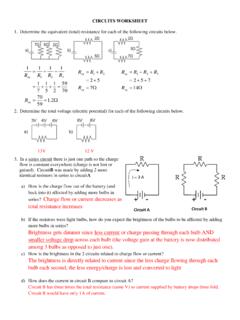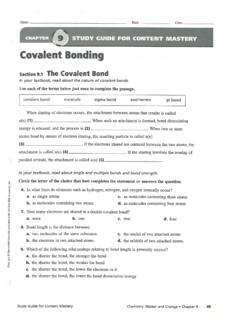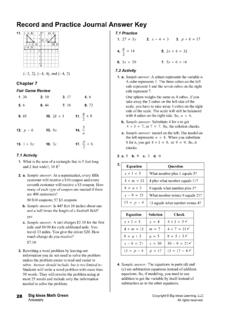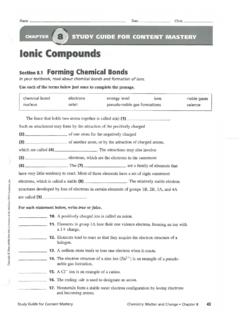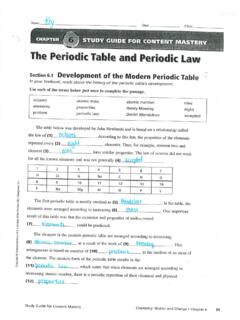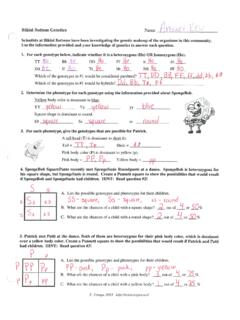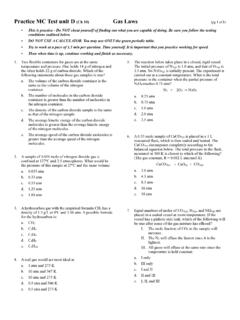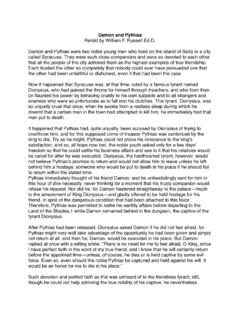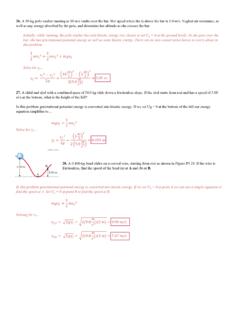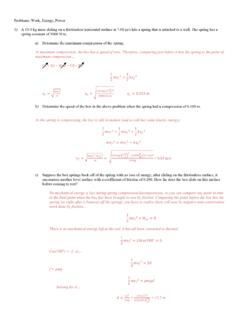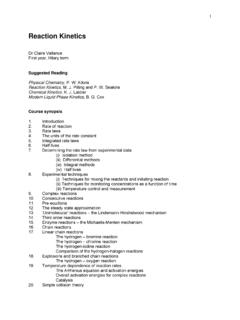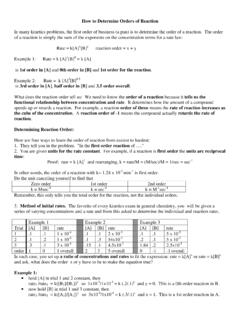Transcription of NOTES: CHEMICAL REACTIONS
1 1 CHAPTER 11 NOTES: CHEMICAL REACTIONS VOCABULARY: Products what is formed in a CHEMICAL reaction; right of arrow Reactants what goes into a CHEMICAL reaction; left of arrow yields + and (s) solid (l) liquid (g) gas (aq) aqueous only works when dissolved in water Catalyst a substance that speeds up a reaction but is not itself consumed; provides an easier reaction pathway that requires less activation energy Activation Energy (Ea) energy necessary to initiate a CHEMICAL reaction heat Pt ENERGY OF CHEMICAL REACTIONS : Exothermic Reaction: H is Endothermic Reaction: H = + (heat is a product ) (heat is a reactant ) Energy Time Energy Time 2 BALANCED CHEMICAL REACTIONS Law of Conservation of Matter: matter cannot be created or destroyed in a CHEMICAL reaction WORD FORMULA BALANCED EQUATIONS 1.
2 Word equation: Hydrogen gas reacts with oxygen gas to form water formula equation: ____ H2 + O2 H2O _____ diagram: H H + O = O O + O H H H H H H balanced reaction ____2 H2 + O2 2 H2O _____ 2. word equation: Magnesium reacts with hydrochloric acid solution (HCl in water) to form magnesium chloride and hydrogen. Formula equation: ____ Mg + HCl MgCl2 + H2 _____ diagram: Mg + H Cl Cl-1Mg+2Cl-1 + H H H Cl balanced reaction _____ Mg + 2 HCl MgCl2 + H2 _____ 3 Try balancing these CHEMICAL REACTIONS : a. 2 Na + H2SO4 Na2SO4 + H2 b.
3 2 K + Cl2 2 KCl c. S8 + 8 O2 8 SO2 d. 3 F2 + 2 FeBr3 2 FeF3 + 3 Br2 e. 3 H2SO4 + 2 Al Al2(SO4)3 + 3 H2 f. 2 NaNO3 + Ca(MnO4)2 2 NaMnO4 + Ca(NO3)2 g. C4H8 + 6 O2 4 CO2 + 4 H2O h. 2 C2H6 + 7 O2 4 CO2 + 6 H2O 4 Balancing CHEMICAL Equations Balance the equations below.
4 1) ____ N2 + ____ H2 ____ NH3 2) ____ KClO3 ____ KCl + ____ O2 3) ____ NaCl + ____ F2 ____ NaF + ____ Cl2 4) ____ H2 + ____ O2 ____ H2O 5) ____ Pb(OH)2 + ____ HCl ____ H2O + ____ PbCl2 6) ____ AlBr3 + ____ K2SO4 ____ KBr + ____ Al2(SO4)3 7) ____ CH4 + ____ O2 ____ CO2 + ____ H2O 8) ____ C3H8 + ____ O2 ____ CO2 + ____ H2O 9) ____ C8H18 + ____ O2 ____ CO2 + ____ H2O 10) ____ FeCl3 + ____ NaOH ____ Fe(OH)3 + ____NaCl 11) ____ P + ____O2 ____P2O5 12) ____ Na + ____ H2O ____ NaOH + ____H2 13) ____ Ag2O ____ Ag + ____O2 14) ____ S8 + ____O2 ____ SO3 15) ____ CO2 + ____ H2O ____ C6H12O6 + ____O2 16) ____ K + ____ MgBr ____ KBr + ____ Mg 17) ____ HCl + ____ CaCO3 ____ CaCl2 + ____H2O + ____ CO2 18) ____ HNO3 + ____ NaHCO3 ____ NaNO3 + ____ H2O + ____ CO2 19) ____ H2O + ____ O2 ____ H2O2 20) ____ NaBr + ____ CaF2 ____ NaF + ____ CaBr2 ANSWERS: 1) 1 + 3 2 2) 2 2 + 3 3) 2 + 1 2 + 1 4) 2 + 1 2 5) 1 + 2 2 + 1 6) 2 + 3 6 + 1 7) 1 + 2 1 + 2 8) 1 + 5 3 + 4 9) 2 + 25 16 + 18 10) 1 + 3 1 + 3 11) 4 + 5 2 12) 2 + 2 2 + 1 13) 2 4 + 1 14) 1 + 12 8 15) 6 + 6 1 + 6 16) 2 + 1 2 + 1 17) 2 + 1 1 + 1 + 1 18) 1 + 1 1 + 1 + 1 19) 2 + 1 2 20) 2 + 1 2 + 1 5 SYNTHESIS, DECOMPOSITION AND COMBUSTION REACTIONS Types of REACTIONS .
5 Synthesis (Combination), Decomposition and Combustion Synthesis (Combination) A + B AB (1 product only) Decomposition AB A + B (1 reactant only) Combustion of a hydrocarbon CxHy + O2 CO2 + H2O Practice: Balance each reaction below. Then identify the reaction type. a. H2 + Br2 2 HBr __synthesis_____ b. C4H8 + 6 O2 4 CO2 + 4 H2O __combustion_____ c. 2 NaOH Na2O + H2O __decomposition_____ d. Ba(ClO3)2 BaCl2 + 3 O2 __decomposition_____ 6 First write and balance the equation. Then identify the reaction type. e. phosphorus + oxygen tetraphosphorus decoxide __ synthesis _____ 4 P + 5 O2 P4O10 f.
6 Pentane (C5H12) + oxygen carbon dioxide + water __ combustion _____ C5H12 + 8 O2 5 CO2 + 6 H2O g. magnesium chlorate magnesium chloride + oxygen ___ decomposition _____ Mg(ClO3)2 MgCl2 + 3 O2 h. when solid calcium carbonate is heated calcium oxide and carbon dioxide are formed ___ decomposition _____ CaCO3 CaO + CO2 i. the formation of calcium nitride from calcium and nitrogen ___ synthesis _____ 3 Ca + N2 Ca3N2 j. sulfur trioxide mixes with water in the atmosphere to form sulfuric acid ___ synthesis _____ SO3 + H2O H2SO4 7 NOTES: SINGLE REPLACEMENT REACTIONS & DOUBLE REPLACEMENT REACTIONS 1.
7 Single Displacement REACTIONS (aqueous ONLY) metals: standard: A(s) + BX (aq) AX (aq) + B(s) example: Cu + 2 AgNO3 Cu(NO3)2 + 2 Ag metal + acid: standard: A(s) + HX (aq) AX (aq) + H2(g) example: Mg + 2 HCl MgCl2 + H2 metal + water: standard: A(s) + H2O(l) AOH(aq) + H2(g) example: 2 K + 2 H2O 2 KOH + H2 halogens: standard: X2 + AY AX + Y2 example: F2 + 2 KI 2 KF + I2 2. Double Displacement (aqueous only) standard : AX (aq) + BY (aq) AY(aq) + BX(s) example : Ba(NO3)2 + NaI BaI2 + NaNO3 3.
8 Identify the reaction type for each reaction below. Then complete and balance the reaction. _single displacement_ a. Ba + 2 AgNO3 Ba(NO3)2 + 2 Ag __single displacement_____b. F2 + 2 KI 2 KF + I2 __double displacement c. NaOH + CaCl2 2 NaCl + Ca(OH)2 ___single displacement d. Zn + H2SO4 ZnSO4 + H2 8 WRITING WORD EQUATIONS __decomposition_____1. aluminum chlorate aluminum chloride + oxygen 2 Al(ClO3)3 9 O2 + 2 AlCl3 __SR_____ 2. lithium + iron (III) nitrate lithium nitrate + iron 3 Li + Fe(NO3)3 3 LiNO3 + Fe __decomposition_____ 3.
9 Magnesium carbonate magnesium oxide + carbon dioxide MgCO3 MgO + CO2 __synthesis_____ 4. tin + nitrogen tin (IV) nitride 3 Sn + 2 N2 Sn3N4 __SR_____ 5. Zinc reacts with nitric acid to form zinc nitrate and hydrogen Zn + 2 HNO3 Zn(NO3)2 + H2 __decomposition_____6. calcium hydroxide breaks down to form calcium oxide and water Ca(OH)2 CaO + H2O WRITING WORD EQUATIONS WITH PREDICTING PRODUCTS __synthesis_____ 1. aluminum + oxygen 4 Al + 3 O2 2 Al2O3 __SR_____ 2. sodium + silver nitrate Na + AgNO3 NaNO3 + Ag __SR_____ 3. magnesium + hydrochloric acid Mg + 2 HCl MgCl2 + H2 ___DR_____ 4. solutions of iron (III) nitrate + potassium sulfate are mixed 2 Fe(NO3)3 + 3 K2SO4 Fe2(SO4)3 + 6 KNO3 ____SR_____ 5.
10 Chlorine gas is bubbled through a solution of lithium iodide Cl2 + 2 LiI 2 LiCl + I29 PREDICTING PRODUCTS 1) ____ Ag2SO4 + __2__ NaNO3 2 AgNO3 + Na2SO4 2) __2__ NaI + ____ CaSO4 CaI2 + Na2SO4 3) __2__ HNO3 + ____ Ca(OH)2 2 H2O + Ca(NO3)2 4) ____ Zn + ___2__ HNO3 Zn(NO3)2 + H2 5) ____ AlCl3 + ____ (NH4)3PO4 AlPO4 + 3 NH4Cl 6) ___3_ Pb + ___2_ Fe(NO3)3 3 Pb(NO3)2 + 2 Fe 7) ___2_ C3H6 + __9__ O2 6 CO2 + 6 H2O 8) ____ Ca + ____ Na2SO4 CaSO4 + 2 Na 10 PREDICTING PRODUCTS FOR THREE TYPES OF DECOMPOSITION REACTIONS : Try: a. strontium carbonate _____strontium oxide + carbon dioxide_____ ____SrCO3 SrO + CO2_____ b.
